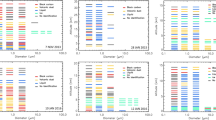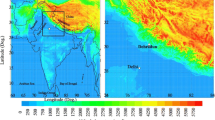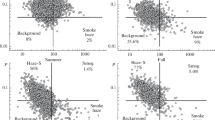Abstract
Vertical structures of aerosols from the ground to about 1,000 m altitude in Beijing were measured with a balloon-borne optical particle counter. The results showed that, in hazy days, there were inversions at approximately 500–600 m, below which the particulate matters were well mixed vertically, while the concentration of particles decreased sharply above the mixing layer. Electron microscopic observation of the particles collected with the balloon-borne impactor indicates that the composition of particles is different according to weather conditions in the boundary mixing layer of Beijing city and suggests that dust particles are always dominant in coarse-mode particles. Interestingly, sea-salt particles are frequently identified, suggesting the importance of marine air inflow to the Beijing area even in summer. The Ca-rich spherical particles are also frequently identified, suggesting chemical modification of dust particle by NOx or emission of CaO and others from local emission. Additionally, those types of particles showed higher concentration above the mixing layer under the relatively calm weather condition of summer, suggesting the importance of local-scale convection found in summer which rapidly transported anthropogenic particles above the mixing layer. Lidar extinction profiles qualitatively have good consistency with the balloon-borne measurements. Attenuation effects of laser pulse intensity are frequently observed due to high concentration of particulate matter in the Beijing atmosphere, and therefore quantitative agreement of lidar return and aerosol concentration can be hardly observed during dusty condition. Comparing the depolarization ratio obtained from the lidar measurements with the balloon-borne measurements, the contribution of the dry sea-salt particles, in addition to the dust particles, is suggested as an important factor causing depolarization ratio in the Beijing atmosphere.






Similar content being viewed by others
References
Benjamin, G., Jean-Claude, R., Hélène, C., Wang, P.-C., Bai, J.-H., & Yu, T. (2006). Impact of vertical atmospheric structure on Beijing aerosol distribution. Atmospheric Environment, 40(27), 5167–5180.
Bian, L.-G., Cheng, Y.-J., Wang, X., Gao, Z.-Q., Wang, Y., & Lu, L.-H. (2002). Observational study of wind and remperature profiles of urban boundary layer in Beijing winter. Journal of Applied Meteorological Science, S13, 13–25.
Chan, C. Y. (2005). Characteristics of vertical profiles and sources of PM2.5, PM10 and carbonaceous species in Beijing. Atmospheric Environment, 39(28), 5113–5124.
Chen, W.-N., Chou Charles, C.-K., Chen, Y.-W., & Chen, J.-P. (2007a). Study of relationship between water-soluble Ca2+and lidar depolarization ratio for spring aerosol in the boundary layer. Atmospheric Environment, 41(7), 1440–1455.
Chen, W.-N., Tsai, F.-J., Chou Charles, C.-K., Chang, S.-Y., & Chen, Y.-W. (2007b). Optical properties of Asian dusts in the free atmosphere measured by Raman lidar at Taipei, Taiwan. Atmospheric Environment, 41(36), 7698–7714.
Han, L.-H., Zhuang, G.-S., Cheng, S.-Y., & Li, J. (2007). The mineral aerosol and its impact on urban pollution aerosols over Beijing China. Atmospheric Environment, 41(35), 7533–7546.
Hayashi, M., Iwasaka, Y., Watanabe, M., Shibata, T., Fujiwara, M., Adachi, H., … & Tsuchiya, M. (1998). Size and number concentration of liquid PSCs: Balloon-borne measurements at Ny-Alesund, Norway in winter of 1994/1995. Journal of the Meteorological Society of Japan, 76, 549–560.
Iwasaka, Y., Yamato, M., Imasu, R., & Ono, A. (1988). Transport of Asian dust (Kosa) particles: Importance of weak Kosa events on the geochemical cycle of soil particles. Tellus Series B, 40, 494–503.
Kim, Y.-S., Iwasaka, Y., Shi, G.-Y., Nagatani, T., Shibata, T., Trochkine, D., … & Nakata, H. (2003). Dust particles in the free atmosphere over the desert areas in the Asian continent: Measurements in summer 2001 to summer 2002 with balloon-borne OPC and lidar at Dunhuang, China. Journal of Geophysical Research, 108, 8643. doi:10.1029/20002JD003269.
Kwon, S.-A., Iwasaka, Y., Shibata, T., & Sakai, T. (1997). Vertical distribution of atmospheric particles and water vapor densities in the free troposphere: Lidar measurement in spring and summer in Nagoya Japan. Atmospheric Environment, 31, 1459–1465.
Madnawat, P.-V.-S., Rani, A., Sharma, M., Prasad, D.-S.-N., & Gupta, K.-S. (1993). Role of surface and leached metal ion catalysis in autoxidation of sulphur (IV) in power plant flyash suspensions. Atmospheric Environment. Part A. General Topics, 27(13), 1985–1991.
Matsuki, A., Iwasaka, Y., Shi, G.-Y., Chen, H.-B., Osada, K., Zhang, D., … & Nakata, H. (2005). Heterogeneous sulfate formation on dust surface and its dependence on mineralogy: Balloon-borne observations from balloon-borne measurements in the surface atmosphere of Beijing China. Water, Air, & Soil Pollution: Focus, 5, 101–132.
Murayama, T., Okamoto, H., Kaneyasu, N., Kamataki, H., & Miura, K. (1999). Application of lidar depolarization measurement in the atmospheric boundary layer: Effects of dust and sea-salt particles. Journal of Geophysical Research, 104, 31781–31792.
Murayama, T., Sugimoto, N., Uno, I., Kinoshita, K., Aoki, K., Hagiwara, N., … & Iwasaka, Y. (2001). Ground-based network observation of Asia dust events of April 1998 in East Asia. Journal of Geophysical Research, 106, 18345–18359.
Pilinis, C., & Li, X. (1998). Particle shape and internal inhomogeneity effects on the optical properties of tropospheric aerosols of relevance to climate forcing. Journal of Geophysical Research, 103(D4), 3789–3800.
Sakai, T., Shibata, T., Kwon, S. A., Kim, Y. S., Tamura, K., & Iwasaka, Y. (2002). Free tropospheric backscatter, depolarization ratio, and relative humidity measured with the Raman lidar at Nagoya in 1994–1997: Contributions of aerosols from the Asian Continent and the Pacific Ocean. Atmospheric Environment, 34, 431–442.
See, S.-W., Balasubramanian, R., & Wang, W. (2006). A study of the physical, chemical, and optical properties of ambient aerosol particles in Southeast Asia during hazy and non-hazy days. Journal of Geophysical Research, 111, D10S08. doi:10.1029/2005JD006180.
Shimizu, A., Sugimoto, N., Matsui, I., Arao, K., Uno, I., Murayama, T., … & Yamazaki, A. (2004). Continuous observations of Asian dust and other aerosols by polarization lidars in China and Japan during ACE-Asia. Journal of Geophysical Research, 109, D19S17. doi:10.1029/2002JD003253.
Su, W.-H., Song, W.-Z., Luo, C., & Ma, C.-G. (1991). Chemical composition of atmospheric aerosol in Beijing-Tianjin and other typical regions in China. Journal of Aerosol Science, 22(Supplement 1), S601–S604.
Sumedha, M. (2011). Growth of biodiesel plant in fly ash: A sustainable approach response of jatropha curcus, a biodiesel plant in fly ash amended soil with respect to pigment content and photosynthetic rate. Procedia Environmental Sciences, 8, 421–425.
Wang, S.-Y., & Zhang, X.-L. (2002). Meteorological features of PM10 pollution in Beijing. Journal of Applied Meteorological Science (in Chinese), 13, 177–184.
Wang, Y., Zhuang, G.-S., Sun, Y.-L., & An, Z.-S. (2006). The variation of characteristics and formation mechanisms of aerosols in dust, haze, and clear days in Beijing. Atmospheric Environment, 40(34), 6579–6591.
Xu, L., Okada, K., Iwasaka, Y., Hara, K., Okuhara, Y., Tsutsumi, Y., & Shi, G.-Y. (2001). The composition of individual aerosol particle in the troposphere and stratosphere over Xianghe (39.45°N, 117.0°E), China. Atmospheric Environment, 35(18), 3145–3153.
Yu, S.-Q., Lin, X.-C., & Xu, X.-D. (2002). Temporal and spatial characteristics of air pollution in Beijing. Journal of Applied Meteorological Science (in Chinese), 13, 92–99.
Yuan, H., Zhuang, G.-S., Li, J., Wang, Z.-F., & Li, J. (2008). Mixing of mineral with pollution aerosols in dust season in Beijing: Revealed by source apportionment study. Atmospheric Environment, 42(9), 2141–2157.
Zhang, R.-J., Cao, J.-J., Lee, S.-C., Shen, Z.-X., & Ho, K.-F. (2007). Carbonaceous aerosols in PM10 and pollution gases in winter in Beijing. Journal of Environmental Sciences, 19(5), 564–571.
Zhang, D., & Iwasaka, Y. (1999). Nitrate and sulphate in individual Asian dust-storm particles in Beijing, China in spring of 1995 and 1996. Atmospheric Environment, 33, 3213–3223.
Zhang, Q., Ma, X.-C., Tie, X.-X., Huang, M.-Y., & Zhao, C.-S. (2009). Vertical distributions of aerosols under different weather conditions: Analysis of in situ aircraft measurements in Beijing, China. Atmospheric Environment, 43(34), 5526–5535.
Zhang, D., Shi, G.-Y., Iwasaka, Y., Hu, M., & Zang, J. (2005). Anthropogenic calcium particles observed in Beijing and Qingdao China. Water, Air, & Soil Pollution: Focus, 5, 261–276.
Zhang, R.-J., Wang, M.-X., Zhang, W., Wang, Y.-S., Li, A.-G., & Zhu, G.-H. (2000). Research on elemental concentrations and distributions of aerosols in Winter/Spring in Beijing. Climatic and Environmental Research (in Chinese), 5(1), 6–12.
Zhang, W.-J., Zhuang, G.-S., Guo, J.-H., Xu, D.-Q., Wang, W., Baumgardner, D., & Yang, W. (2010). Sources of aerosol as determined from elemental composition and size distributions in Beijing. Atmospheric Research, 95(2–3), 197–209.
Acknowledgments
This work was supported by the National Natural Science Foundation of China (Grant No. 41475136), supported by International Science & Technology Cooperation Program of China (Grant No. 2013DFG22820), supported by the National Natural Science Foundation of China (Grant No. 41130104) and supported by Open Research Fund of Key Laboratory of Atmospheric Composition and Optical Radiation, Chinese Academy of Sciences. The authors are also thankful to the staff of Beijing Meteorological Observatory for the kind support on the meteorological data and for the help in launching the balloon.
Author information
Authors and Affiliations
Corresponding authors
Rights and permissions
About this article
Cite this article
Chen, B., Yamada, M., Iwasaka, Y. et al. Origin of non-spherical particles in the boundary layer over Beijing, China: based on balloon-borne observations. Environ Geochem Health 37, 791–800 (2015). https://doi.org/10.1007/s10653-014-9668-6
Received:
Accepted:
Published:
Issue Date:
DOI: https://doi.org/10.1007/s10653-014-9668-6




